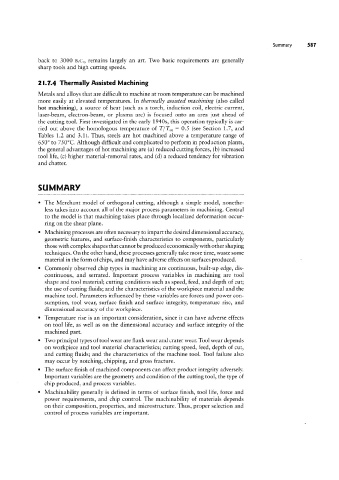Page 606 - 04. Subyek Engineering Materials - Manufacturing, Engineering and Technology SI 6th Edition - Serope Kalpakjian, Stephen Schmid (2009)
P. 606
Summary 587
back to 3000 B.C., remains largely an art. Two basic requirements are generally
sharp tools and high cutting speeds.
2l.1.4 Thermally Assisted Machining
Metals and alloys that are difficult to machine at room temperature can be machined
more easily at elevated temperatures. In thermally assisted machining (also called
hot machining), a source of heat (such as a torch, induction coil, electric current,
laser-beam, electron-beam, or plasma arc) is focused onto an area just ahead of
the cutting tool. First investigated in the early 1940s, this operation typically is car-
ried out above the homologous temperature of T/ Tm = 0.5 (see Section 1.7, and
Tables 1.2 and 3.1). Thus, steels are hot machined above a temperature range of
650° to 75 0°C. Although difficult and complicated to perform in production plants,
the general advantages of hot machining are (a) reduced cutting forces, (b) increased
tool life, (c) higher material-removal rates, and (d) a reduced tendency for vibration
and chatter.
SUMMARY
° The Merchant model of orthogonal cutting, although a simple model, nonethe-
less takes into account all of the major process parameters in machining. Central
to the model is that machining takes place through localized deformation occur-
ring on the shear plane.
° Machining processes are often necessary to impart the desired dimensional accuracy,
geometric features, and surface-finish characteristics to components, particularly
those with complex shapes that cannot be produced economically with other shaping
techniques. On the other hand, these processes generally take more time, waste some
material in the form of chips, and may have adverse effects on surfaces produced.
° Commonly observed chip types in machining are continuous, built-up edge, dis-
continuous, and serrated. Important process variables in machining are tool
shape and tool material; cutting conditions such as speed, feed, and depth of cut;
the use of cutting fluids; and the characteristics of the workpiece material and the
machine tool. Parameters influenced by these variables are forces and power con-
sumption, tool wear, surface finish and surface integrity, temperature rise, and
dimensional accuracy of the workpiece.
° Temperature rise is an important consideration, since it can have adverse effects
on tool life, as well as on the dimensional accuracy and surface integrity of the
machined part.
° Two principal types of tool wear are flank wear and crater wear. Tool wear depends
on workpiece and tool material characteristics; cutting speed, feed, depth of cut,
and cutting fluids; and the characteristics of the machine tool. Tool failure also
may occur by notching, chipping, and gross fracture.
' The surface finish of machined components can affect product integrity adversely.
Important variables are the geometry and condition of the cutting tool, the type of
chip produced, and process variables.
° Machinability generally is defined in terms of surface finish, tool life, force and
power requirements, and chip control. The machinability of materials depends
on their composition, properties, and microstructure. Thus, proper selection and
control of process variables are important.

